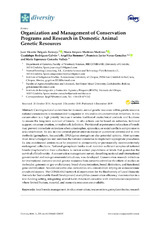Mostrar el registro sencillo del ítem
Organization and Management of Conservation Programs and Research in Domestic Animal Genetic Resources
| dc.contributor.author | Delgado-Bermejo, J.V. | |
| dc.contributor.author | Martínez Martínez, Amparo | |
| dc.contributor.author | Rodríguez Galván, Guadalupe | |
| dc.contributor.author | Stemmer, Angélika | |
| dc.contributor.author | Navas González, Francisco Javier | |
| dc.contributor.author | Camacho Vallejo, M.E. | |
| dc.date.accessioned | 2019-12-10T07:34:25Z | |
| dc.date.available | 2019-12-10T07:34:25Z | |
| dc.date.issued | 2019 | |
| dc.identifier.uri | http://hdl.handle.net/10396/19183 | |
| dc.description.abstract | Creating national committees for domestic animal genetic resources within genetic resource national commissions is recommended to organize in situ and ex situ conservation initiatives. In situ conservation is a high priority because it retains traditional zootechnical contexts and locations to ensure the long-term survival of breeds. In situ actions can be based on subsidies, technical support, structure creation, or trademark definition. Provisional or permanent relocation of breeds may prevent immediate extinction when catastrophes, epizootics, or social conflicts compromise in situ conservation. Ex situ in vivo (animal preservation in rescue or quarantine centers) and in vitro methods (germplasm, tissues/cells, DNA/genes storage) are also potential options. Alert systems must detect emergencies and summon the national committee to implement appropriate procedures. Ex situ coordinated centers must be prepared to permanently or provisionally receive extremely endangered collections. National germplasm banks must maintain sufficient samples of national breeds (duplicated) in their collections to restore extinct populations at levels that guarantee the survival of biodiversity. A conservation management survey, describing national and international governmental and non-governmental structures, was developed. Conservation research initiatives for international domestic animal genetic resources from consortia centralize the efforts of studies on molecular, genomic or geo-evolutionary breed characterization, breed distinction, and functional gene identification. Several consortia also consider ex situ conservation relying on socioeconomic or cultural aspects. The CONBIAND network (Conservation for the Biodiversity of Local Domestic Animals for Sustainable Rural Development) exemplifies conservation efficiency maximization in a low-funding setting, integrating several Latin American consortia with international cooperation where limited human, material, and economic resources are available. | es_ES |
| dc.format.mimetype | application/pdf | es_ES |
| dc.language.iso | eng | es_ES |
| dc.publisher | MDPI | es_ES |
| dc.rights | https://creativecommons.org/licenses/by/4.0/ | es_ES |
| dc.source | Diversity 11(12), 235 (2019) | es_ES |
| dc.subject | Local breeds | es_ES |
| dc.subject | Management | es_ES |
| dc.subject | In situ conservation | es_ES |
| dc.subject | Rescue centers | es_ES |
| dc.subject | Germplasm banks | es_ES |
| dc.subject | Research | es_ES |
| dc.title | Organization and Management of Conservation Programs and Research in Domestic Animal Genetic Resources | es_ES |
| dc.type | info:eu-repo/semantics/article | es_ES |
| dc.relation.publisherversion | http://dx.doi.org/10.3390/d11120235 | es_ES |
| dc.rights.accessRights | info:eu-repo/semantics/openAccess | es_ES |

